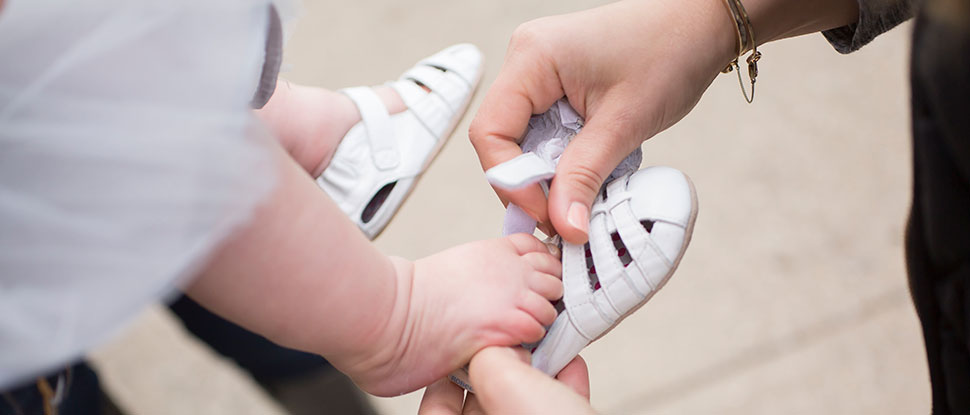What are the Developmental Stages of Baby Feet?
14th Jun 2018

Take a look at your baby’s scrumptious, chubby little feet. Aside from being immeasurably cute, they look pretty similar to your own, right? Externally, newborn and baby feet seem to be miniature copies of adult feet, but don’t let appearances fool you. Your child’s feet are undergoing a developmental process unique to their age, and while they might look just like your feet, they are both structurally and materially distinct. With each developmental stage your baby’s feet will change as they find new ways to move, from those early wiggles to walking all on their own.
Pre-walkers & Crawlers
Any child who hasn’t yet shown interest in walking or standing falls into the pre-walker or crawler group. Great developments occur in this first 6 to 10 months as the basic structures of the foot start to take shape. You can expect your baby’s feet to grow three sizes and measure half the length of their eventual adult foot by their first birthday!
Newborns enter the world with no bones in their feet at all. Rather, they have what is best described as a spongey cartilage that will slowly ossify into the 26 bones and 33 joints that comprise a normal adult foot. The process of ossification will not complete until age 18, but it’s in these first, pre-walker months that your baby’s feet are the most delicate.
Containing soft cartilage rather than hard bone, babies’ feet can sustain developmental abnormalities when not cared for properly. Constrictive or ill-fitting shoes and socks place repeated pressures and tensions on the foot that can impede growth or cause developmental problems that persist for years. For healthy baby feet, be sure to check the fit of your little one’s footwear often, prepare to replace shoes every few months, and allow them to go barefoot as much as possible. When shoes are a must, always opt for a soft sole to let those little toes stretch and strengthen as they prepare for their next great adventure.
Cruisers
Another name for beginner walkers, cruisers are ready to explore the world on their own two feet—almost. Somewhere between their 8 and 10-month milestones your baby will probably begin to try standing on their own. They’ll use everything from the sofa, to your leg, to the family dog for support, and there are bound to be some bumps along the way. In as soon as three weeks after they first stand you’ll likely find your little one starting to shuffle along as they hold on to objects for support.
All of this standing and cruising business is hard developmental work. It will require a lot of determination on the part of your child as they labor to strengthen and tone their muscles. By now their soft cartilage has become strong enough to support their weight, though their feet remain delicate. You may notice, too, that their pudgy little feet still lack an arch. This is perfectly normal. Children often don’t show signs of an arch until the age of 7.
In these early walking days your baby’s feet are making great progress, but they are undergoing tremendous emotional growth as well. Remember to cheer at their successes, congratulate their efforts, and soothe them when they fall, but don’t be afraid to let them make mistakes. Children must learn to accept falling as they progress toward independent walking. And remember: every time they fall and get back up your child is growing not just their muscular strength, but their emotional strength as well. Just continue checking for signs that it’s time for a new shoe size, and keep encouraging your little one to explore.
Walkers and Toddler
By this stage your baby is starting to make big strides. Bones and joints continue to form and fuse as muscles and tendons take on new challenges, and at anywhere between 9 to 17 months, they’ll take their first steps. You may be thinking, that’s is a huge range, and it is! While on average, babies begin to walk at 10 to 12 months, many perfectly healthy babies take far longer. Every child’s foot develops at its own pace, and every baby walks in their own time.
At this point in development your child may display some atypical stances including in-toeing, out-toeing, bow-leggedness or tiptoeing. While we consider these postures abnormal in adults, they’re fairly common in walkers and toddlers. In fact, they’re often the result of the nine months your baby spent cramped in the womb, scrunched into positions that contorted particular muscles. Walking helps to extend and flex those muscles, eventually restoring them to their full range of motion. Most children outgrow these painless habits by the age of 3 with no lasting effects.
At Robeez, we want to emphasize and celebrate the unique spirit of each and every baby. From their first precious smile to those first tottering steps, your little one will reach their milestones in their own patented style. As their biggest fan, you’ll discover who they are as they begin to show the world what they can do. Take it all in because before you know it you’ll be chasing them down the hall at changing time.
